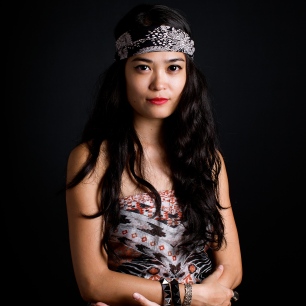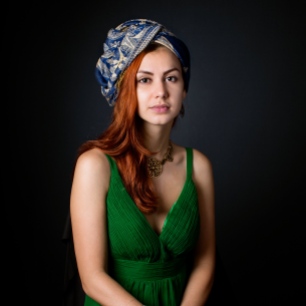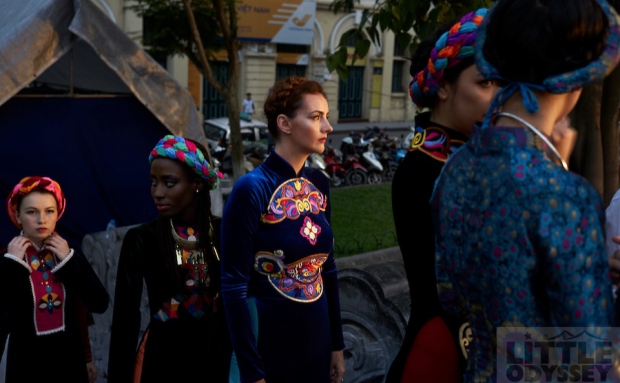A few months ago I was invited to join a photography project exploring the identity of international residents living in Hanoi. The only mandatory obligation was that the model must wear a headdress of some kind in a bid to disguise their traditional appearance. Intrigued I agreed to participate as I saw it as a rare opportunity to appropriate my Vietnamese hill tribe accessories with contemporary fashion trends for a credible cause. (reading time 10 minutes)
About Babylon 21 Transcending Ethnicity
“This series of photographic portraits by Alisher Sharip represents the diversity of Hanoi, an amazing ethnic and cultural melting pot that is home to people from all around the world.
Moving from portrait to portrait, the viewer’s eyes go on a journey of individuals shaped not only by the communities in which they grew up but also by life in cosmopolitan Hanoi, an environment that often triggers creativity and allows a person the chance to develop abilities otherwise repressed by the demanding social-economic reality of the places they came from.
Life in Hanoi challenges identity at all levels, professional, social, religious and cultural. By stepping out of the stream of daily routine and creating unconventional images, the participants question the concept of ethnicity itself and demonstrate how contemporary cities eliminate ethnic boundaries and create global citizens.” For more information visit the event page on Facebook.
Interview with photography Alisher Sharip
- Can you briefly describe your background and experience in relation to working creatively and living in a multicultural society.
In a way I’ve lived in a multicultural societies for all my life. Born in a mixed family in Uzbekistan (USSR at that time), I grew up in Belarus, did my MA and PhD in St. Petersburg, worked in the US and Vietnam. In all those countries I’ve always been a foreigner occupied in creative fields like icon painting, copywriting, journalism, TV production and scholarly research. The camera has been my working tool since early 2000s and a few years ago I started to make a living as a freelance photographer.
- How did the project start? Are there any personal experiences that inspired the project?
It started spontaneously. I was working on a series of portraits of Mai Khoi the singer, and one day we were having a session with her and another singer, Dong Lan, they both wore scarves on their heads and I was amazed how the beauty of their facial treats stood out. Combining headpieces with ethnic clothes, I experimented the concept with a few other people. Hoang Minh Chau suggested making more similar portraits for an exhibition.
- You previously named the project Ethnica, why did you change the title to Babylon 21: Transcending Ethnicity?
Ethnica sounded too broad. At some point I started thinking how to narrow it down and focus on the national and ethnic diversity of Hanoi. Then the metaphor of Babylon popped out in my mind and I decided to use 21 as a reference to both 21st century and the number of participants that equally distributes gender presence.
- How many people from different cultures and ethnicities are involved in the exhibition?
There are people from different Asian countries, Europe, Middle East, and Africa. Quite a few people in the series have mixed ethnic origins.
- What is the significance of the cultural costume, headdresses or props in the portraits?
My idea was to take people out of their everyday context, make them look different but still the way they wanted to look. So I asked them to prepare any sort of ethnic outfit they could think of – not necessarily representing their ethnicity but anything they associated themselves with. It was interesting to observe how some of them preferred their traditional costumes and others experimented putting together various national elements of costume, accessories and props to construct their identity.
- Working in fashion design and specialising in cultural costume I understand that our first impressions are often heavily influenced by the way individuals dress, do you think Babylon 21: Transcending Ethnicity challenges social stereotyping?
In a way it does. When we see a person dressed like that we are puzzled for a moment trying to classify what we see. Traditional “hippie” label doesn’t always work these days so we might have to think of a new decoding system to read people’s style.
- As a participant for me the project aspires to explore, challenge and combine the visual identity of the diverse ethnic and cultural community currently residing in Hanoi, would you say this is a accurate perception?
Yes and no. I didn’t try to show what people really wear in Hanoi in order to create or highlight their identity. It was rather an attempt to change the frame, get rid of conventional brand clothes that we usually wear without thinking twice. I wanted people to look different. And I liked the transformation. Human beauty shines when our ordinary perception is shaken a bit, when we visually slapped in the face and puzzled for a moment. I can’t wait to see participants at the opening, browsing among their portraits, taking selfies next to their framed images and comparing themselves with their photographic doubles.
- Will you reveal the portrait participants true ethnicity or will the observer have to guess?
I decided not to reveal their ethnic identities. Let it be a little hide and seek for the audience.
- How do you think multicultural communities have changed the creative scene in Vietnam over the past 10 years?
Dramatically. I came here 8 years ago and couldn’t find a joint with live music. Vietnamese artists were trying to create new forms coming up with something that had been out of date at the Western art scene for decades. I observed the emergence of the musical groups and was myself a part of it for a few years. I remember how traveling musicians Jason and Luke started Cinemusic Wednesdays and Phuong Dang was a part of it too and the place was always packed with local and foreign listeners. Now you can just open Grapewine or TNH and pick a gig where to go every day. It’s a completely different world and huge part of this change is multicultural influence.
On Wednesday 3rd June 2015 my portrait and 20 others will feature in a photography exhibition titled Babylon 21, exploring how contemporary multicultural living in the 21st century can challenge, change and create continuous conversation questioning who we perceive people to be based on their appearance.
Babylon 21 photography exhibition opens on Wednesday 3rd June 2015 at 6pm at Chula 43, NHAT CHIEU , 396 LAC LONG QUAN, Hanoi, Vietnam.
















